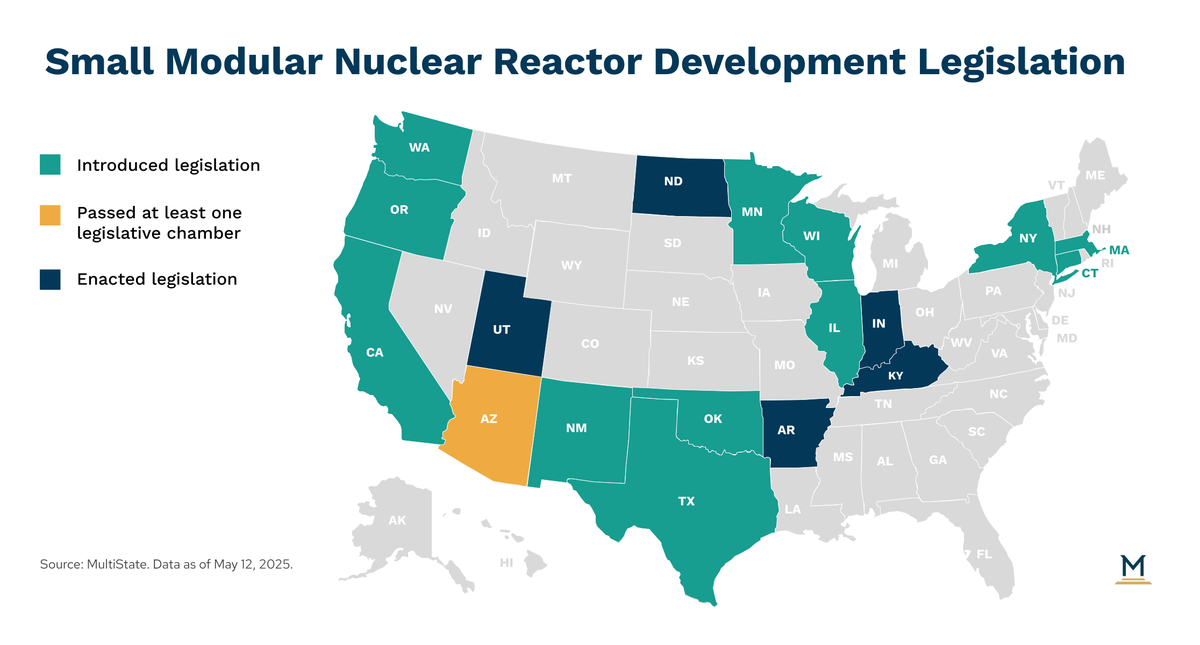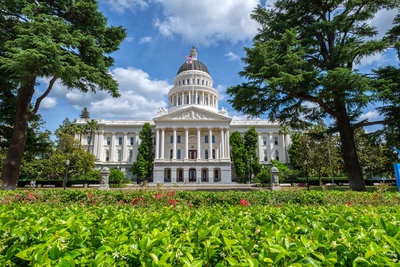
Technology & Privacy
Here's What You Need To Know About Data Center Policy Trends
November 4, 2025 | Morgan Scarboro
May 22, 2025 | Billy Culleton

Key Takeaways:
Data centers have become a policy hotspot, and while there are many policy angles to the huge investments in data centers, energy supply has become a major policy concern for state lawmakers. Technology companies are pouring billions into building large data centers that support artificial intelligence (AI) and other cloud-based computing products. While data centers can provide lucrative revenue streams for local economies, their need for around-the-clock power has policymakers looking for new ways to supply more power to the grid.
A small data center typically consumes around 1-5 megawatts (MW) of power, or enough electricity to power 200-1000 houses. Larger data centers, meanwhile, need anywhere from 20MW to 100MW. Forecasters expect data centers’ share of annual electricity generation to increase from 4% in 2023 to 9% by 2030.
Nuclear energy is a potential energy solution to power these huge data centers that can serve the need for constant power that is also relatively emission-free. Which is why technology companies are increasingly interested in nuclear. Companies such as Meta and Google have recently pledged to triple their use of nuclear energy, including the use of a growing method of bringing nuclear energy online called small modular reactors (SMRs).
SMRs are smaller versions of traditional nuclear plants that typically supply around 300MW of energy per unit. They can be an ideal fit for data centers since SMRs are fairly quick to build compared to larger nuclear plants and can be collocated next to data centers. While no SMRs are currently in operation in the U.S., the first ones are planned to be up and running by early next decade in Texas and Wyoming.
This year, state lawmakers have considered 55 bills across 19 states on encouraging the building of SMRs.

Most of these bills either seek to roll back regulations to allow SMRs a smoother path to come online or provide tax incentives to encourage development. On the regulatory side, Indiana lawmakers enacted a bill (IN SB 424) that allows electric utilities to recover pre-construction costs associated with building SMRs. Since these reactors prevent a huge upfront cost to energy providers, rate recovery provisions lower the financial risk for regulated utilities to invest in SMRs. Lawmakers in California (CA AB 305) and Connecticut (CT SB 4) are both considering bills that allow the construction of advanced small nuclear reactors.
States also need to address the decades-long pushback against traditional nuclear power. Bills introduced in Illinois (HB 3604) and Minnesota (MN SF 1924, MN HF 9, MN SF 572, & MN SF 126) would repeal these states’ prohibitions on new construction of nuclear power plants. While in Arizona, lawmakers passed legislation (AZ HB 2774) that would prevent large counties from regulating SMRs if the reactor met all the necessary zoning requirements. That legislation, however, was ultimately vetoed by Governor Hobbs (D).
Economic incentives are always a powerful financial tool to encourage investment, particularly when it comes to capital-intensive projects like energy. Connecticut’s SB 4 includes a provision for a competitive grant program to help provide funding for advanced nuclear reactors. And a bill enacted in Kentucky (KY SB 179) sets up a $10 million grant program for the development of a nuclear energy facility, with awards up to $2 million per grant. The bill sponsor, Senator Danny Carroll (R), specifically mentioned the need to invest in nuclear energy as a way not only to power data centers but to compete with neighboring states that have expanded investment.
Some lawmakers are choosing the more cautious approach in studying the impact of advanced nuclear technologies like SMRs. Study bills like the ones enacted this year in Arkansas (AR HB 1572) and North Dakota (ND HB 1025) could serve as models for states interested in adding nuclear to their mix that provides a meaningful forum for stakeholder involvement.
MultiState’s team is actively identifying and tracking data center issues so that businesses and organizations have the information they need to navigate and effectively engage. If your organization would like to further track this or other related issues, please contact us.

November 4, 2025 | Morgan Scarboro

October 9, 2025 | Bill Kramer

October 8, 2025 | Bill Kramer